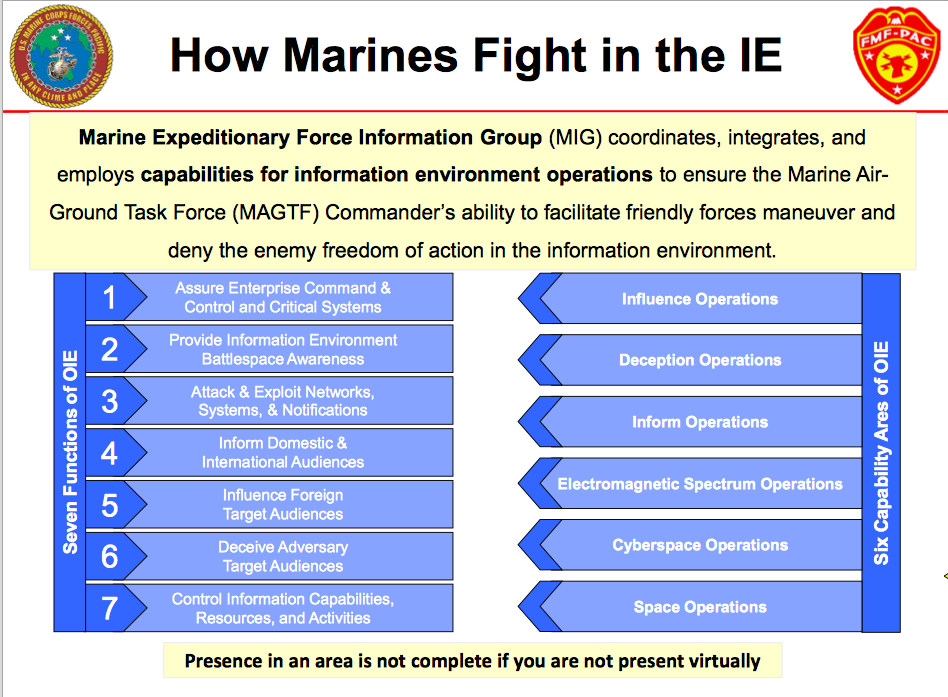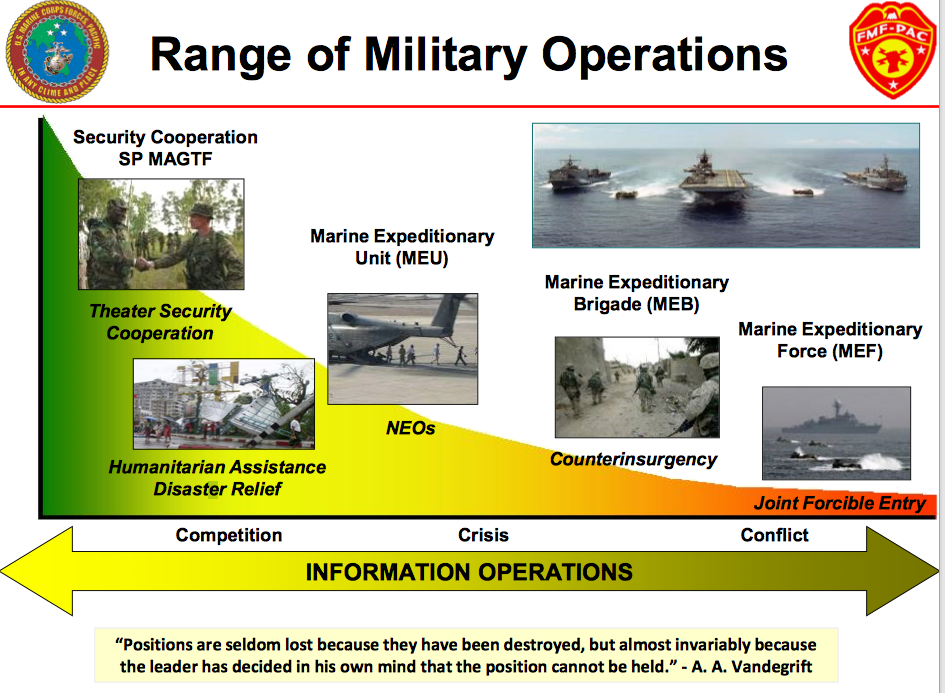By Robbin Laird
During my August 2021 visit to MARFORPAC, I had a chance to talk with the specialists in information operations within the command. In particular, I met with Mr. Justin Bogue, Information Maneuver Branch Deputy, Maj. Melissa Giannetto, MARFORPAC PsyOp Officer and Maj. Nick Mannweiler, COMMSTRAT Operations.
Clearly, one major change since my last visit to MARFORPAC in 2014-2015 has been a renewed focus on information operations.
With the Russian seizure of Crimea which involved significant use of information warfare, and the ramp up of information operations including cyber in the Pacific – China, North Korea and Russia – a focus on crisis management operations needs to incorporate information operations as a core capability.
It needs to be, in the words of one participant in the discussion, “not a bolt-on capability but a core integrated capability.”
A key change which the Marines have made to build out modern IO capabilities has been the formation of MEF Information Groups (MIG) in each Marine Expeditionary Force.
And those MIGS are operating as centers of excellence to shape the practical side of information operations, but also as magnets for change throughout the Marine Corps as a whole.
During a visit to 2nd MEF this past summer, I discussed why the formation of the MIGs was so important as part of the reshaping of the Marine Corps capabilities for full spectrum crisis engagement.
As Col. Brian Russell, the Commander of II MEF Information Group put it: “the MIG was borne out of the MEF Headquarters Group here. We had some of the components already, but they were reorganized under a different construct with some different capabilities, like the communication, strategy and operations company. Psychological operations capabilities, defensive cyber capabilities, were packaged in this MEF Information Group.
“I think the key for the MEF Information Group is taking all those capabilities and making them work together rather than having operational silos such as just coms and just intel; we need to work information operations as a whole.”
The participants in the conversation at Camp Smith with the information operations officers underscored Russell’s core point.
It was about forging a coherent capability to build in information operations elements within operations.
As one participant put it: “It has taken time but over the past few years, we have been able to get wider recognition of the importance of information operations for the Marines and there is now much greater practical focus on how to do this more effectively going forward.”
And one aspect of that challenge going forward is working through what the relationship between what has been traditionally called public affairs is with operational information war. Or put another way:
What is the relationship between COMSTRAT and Information Operations?
Another participant underscored that information operations were a key part of how the U.S. and allied militaries operated in the Cold War.
Some of these skill sets need to be recreated but to do so in the digital age and one where cyber war is a key reality as well.
In the briefing given by the information operations team, one slide highlighted “how the Marines fight in the information environment.”
And the focus was upon how the MIG was positioning itself as a core element within the MAGTF to shape a way ahead for integrated information operations.

Because the Marines are full spectrum crisis management force, IO needs to be addressed across the spectrum of operations from HADR ops, to higher end forcible entry operations.
In the briefing, the team highlighted this in the following slide:

With a focus on more joint force integration of the Marines with the Navy, in particular, it was increasingly important that coordination among service-based IO needs to be coordinated, and common approaches and language shaped to execute more effective joint operations.
And IO against peer competitors was at a very different scale than what has been learned and practiced in the Middle East land wars.
Events at the local level in INDOPACOM can become strategic in character rapidly: how best to handle the management of IO at local levels and ensure that they work hand in glove with effective strategic level decisions?
The exercise piece is of growing importance as well.
Training and exercises are becoming of increasing importance in shaping joint and coalition force capabilities. But they are messaging events as well. How to bring these two strands within exercises more effectively together, namely effective combat training and effective political impacts through messaging?
We discussed the crucial importance of collating information and lessons as well learned in crises, exercises or other information operational events.
And here the team highlighted that from the beginning the MIGS are working closely with one another, and there are clear efforts to shape a coordinated community which can indeed share experiences and knowledge gained from those experiences.
In short, part of the strategic shift which the Marines are undergoing from the land wars to full spectrum crisis management is learning how to master information operations.
And to do so in way that is integrated within kinetic operations as well.
Also, see the following:
The Role of II MEF Information Group: The Perspective of Its Commanding General
For an article by Col. Russell which discusses the challenges which the MIGS are addressing, see the following:
On the COMSTRAT and IO challenge, see the following article:
See also, the following story about the standup of the MIG in III MEF:
Okinawa’s Marine Expeditionary Force Information Group is ready to fight in the information environment
By Sgt.George Melendez
III MEF Information Group reached a historic milestone during the conclusion of the III Marine Expeditionary Force Exercise on Okinawa, May 10, 2019. It is ready to begin operating in the information environment, also referred to as the Initial Operational Capability, by supporting operations in the Indo-Pacific region. This operational level command and control focused exercise contains a fictional scenario developed with a real-world near-peer competitor in mind.
“MEFEX was the first time that we did this and it’s to try to show the value added from the Information Command Center,” said Col. Larry Jenkins, the commanding officer of III MIG. “Showing that we have made ourselves more lethal, more survivable and more flexible.”
The ICC is a new concept but is shaped similar to the Marine Corps’ ground, air and logistics command units. It will bring together information-related capabilities that have existed in the information domain prior to the MIG standing up and focus them in a unified effort on a singular objective to gain information superiority over an adversary.
“(We) want to change the way the Marine Air-Ground Task Force fights, and get it to think of the operations in the information environment as maneuver warfare in a different domain,” said Jenkins.
Examples of the IRCs working alongside of the ICC are cyberspace, electronic warfare, military deception, special technical operations, psychological operations, communications strategy and operations, and intelligence.
The intent of command in the ICC is putting information-related authorities at our level instead of where they traditionally reside in the higher units. Granting those authorities down provides a space to create tempo and speed for subordinate commanders in the information domain, explained Lt. Col. James McGrath, the III MIG operations officer.
In order to grant proper authorities to the ICC, staff members from different units needed to be trained to synchronize with the other IRC’s they may have never worked with before. The training took approximately six months and was executed by building tactics, techniques and standard operating procedures through battle drill rehearsals and staff exercises.
“So, if you look at it now there’s a spectrum of capabilities for the MIG. At the one end, the high end, is the MIG staff here; all the subject matter experts in all of the capabilities that we have been taught and come to understand and integrate into the information environment,” said Jenkins. “On the other end is the standup of tactical-level capabilities within the six battalions that we have in the MIG to execute operations.”
With one historic milestone reached, III MIG’s long term goal is to reach full operational capability by 2025 so they can continue to achieve information superiority throughout the information environment.
May 5, 2019


